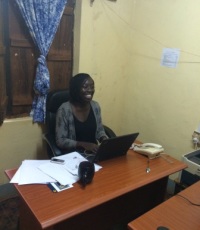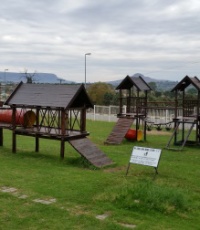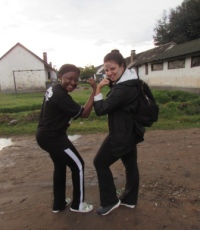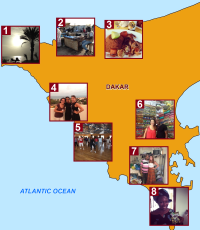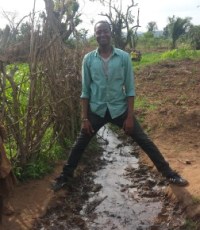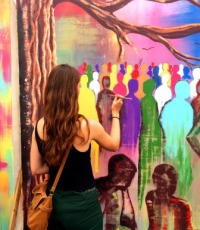November - December 2014
Dear Friends,
We have a great Fellows Flyer to share with you! As they approach the midpoint of their fellowship year, our Fellows continue to make an impact across the African continent – writing grant reports for a cashew industry NGO in Ghana, helping to facilitate staff trainings for a refugee camp in Tanzania, building an eco-friendly bench in rural Kenya, and more. In the midst of all of their hard work, several of our Fellows were able to take a breather for a few days in mid-November to participate in PiAf’s Fall 2014 Fellows’ Regional Meetups. The meetups were an invaluable opportunity for Fellows to come together for the first time since their orientation in June, and to discuss challenges, opportunities and overall reflections and impressions of their fellowship year so far.
Meanwhile, on this side of the Atlantic, PiAf hosted its annual benefit gala in New York City in late October. It was an extraordinary evening in celebration of 15 years of PiAf Fellows, our organization’s remarkable founders, the Tierney family, and the many supporters who make our fellowship program possible. You can see photos from the gala and learn more about the event here.
As the holiday season approaches, PiAf’s staff, board members and alumni are busy reviewing the 442 applications we received for next year’s anticipated 45-50 fellowship posts, as well as applications from fantastic new potential partner organizations. As always, we are amazed by the number of bright, skilled, passionate young adults eager to spend a year of service in Africa, and the inspiring organizations in Africa that are interested in our Fellows’ support.
From everyone here at Princeton in Africa, we wish you a joyful holiday season and a happy new year!
Warm regards,
Katie Henneman
Executive Director
PiAf Connections
Please click below to check out pictures of our Fellows, Alums and other members of the PiAf family meeting up at home and around Africa.
Notes from the Field
By Akua Agyen, 2014-15 Fellow with International Rescue Committee in Tanzania
As the Child Youth Protection and Development Fellow at the International Rescue Committee Kasulu office, I provide program support to staff in Nyarugusu Refugee Camp and in the NMC Transit Centre for refugees. My responsibilities vary in duties and environment. I help to facilitate trainings of our refugee staff in camp. I take part in strategy development discussions, track program spending, and attend interagency meetings. On any given day, I may spend my morning on the phone with a colleague in the DRC and my afternoon discussing life in Nyarugusu with a young refugee who has lived in the camp since birth.
In Kasulu, piki piki or boda boda is the most common form of transportation. The exchange usually begins with the request. I might call “piki piki” to a passing driver, but I usually settle for “psst”—full of suggestion, loaded with meaning, a simultaneously impersonal and conspiratorial request. The driver, usually a man, will then pull over; we will greet and then “wapi?” or “where to?” For me these rides are absolute bliss; beyond the triteness of “I love the feel of the wind blowing through my hair,” these trips are a beautiful way for me to disengage from my role as a member of the community and reconnect through observation.
One day, there was Prosper. I was leaving my first meeting with my mwalimu ya Swahili (Swahili teacher) and was searching for someone to take me to town. Before I could wave or make the telltale “psst,” one slowed. We said our mambos, I gave him my destination, and we were off. His name is Prosper; he was in town from Dar es Salaam only to visit his mother. He had worked with many Ghanaians and rattled off their names, so as to bind us together. Prosper is a freelance journalist. He writes about human rights and has directed a documentary. In fact, Prosper is not at all a boda boda driver. He did not see a client; he saw a “person who looked like they needed a little help.” He refused to take my money. “I am not for hire. It was my pleasure. Don’t forget my jacket, I wear it all the time; so if you see me, call my name and wave hello!”
Without street lights, the lights from small shops and other piki piki catch the settled dust in an eerie way. You can see the outlines of children playing in the road but you can’t tell how many. In the dust, until the moment when your shoulders brush, there are no faces, simply the echoes of footfalls. Above the haze, the sky erupts in nyota (stars). The sky draws you up into it.
Most Friday nights, there is Carlos. Carlos is kind and always greets us by first name. Nana! He greets, loudly and always with a smile. Our conversations are usually about the evening, did I have fun? Where is my friend? He usually assures me that he is taking the safest route to my house, because “the client’s safety is very important.” And then without announcement or hesitation, the class begins: “Do you know pole pole?” “Do you know furaha?” With Carlos, I am sure to learn at least 2 to 3 new words while on the back of his piki piki. He lectures over his shoulder and I listen intently, while calling out Swahili to the stars.
Soon it will be Friday again. I will draw a breath into my lungs, tightly press my lips together, and on the exhale my sharp “psst” cuts through the dust. His head will turn up, the motor will slow down, and I will swell with a little pride and a little excitement. Another evening, another ride.
Notes from the Field
By Margaret Cochrane, 2014-15 Fellow with Nyumbani Village in Kenya
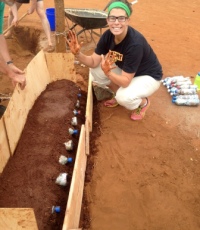
Maggie building an ecobench (made of plastic bottles stuffed with garbage) as part of a recycling project with Lawson High School.
Nyumbani Village is an eco-village in Kenya that houses not only 1,000 children orphaned by HIV/AIDS, but also 100 grandparents who serve as surrogate parents. Some of my favorite parts of daily life here in the Village are my interactions with the grandmothers – or, as they are called here, “susus.” Out of 100 grandmothers, the majority of them only speak Kikamba, the local tribal language. Some speak Swahili and English, but Kikamba is definitely the language of choice. Seeing as my Kikamba knowledge upon arriving in the Village was literally nonexistent, I had to learn quickly how to greet and communicate with the susus. In many African countries, and definitely here in Kenya, respect of elders is a very important part of the culture. Therefore, it was very important for me to learn the Kikamba greetings as soon as I got to the Village. My first interaction with a susu went something like this:
Susu: Watindaata? (looks expectantly at me)
Me: ……..?? (nod my head and smile)
I learned shortly after this encounter that “Watindaata?” means “How are you?” in Kikamba. The proper response is “Nesa vyu” or “very good.” “Wamukata?” also means “how are you?” but is used more in the morning hours. The response is the same, “Nesa vyu.” An elder such as a susu will also greet someone younger with “Wakya?” and you will respond “Aa.” This is a traditional exchange of respect. Some susus like to accompany these exchanges with a firm handshake, hard handclap or fist bump. I know one susu specifically for her enthusiastic handclap and fist bumps that leave my hand stinging.
These greetings have become a highlight of my day. The susus are so full of life and zest. A greeting described above oftentimes turns into a hug and kiss on the cheek or even impromptu dancing. Life is always “nesa vyu vyu vyu!” or very very good! The susus bring brightness to my day with their vivid smiles, vibrant clothes and hospitality. The exchange of greetings connects us, me becoming not just a random mzungu, but also a friend. Twice I have been invited to dinner in susus’ houses where I am fed delicious food until I am beyond stuffed and served sweet chai (tea). Usually the evening ends in dance and singing. These grandmothers and the children do not receive vast amounts of food; therefore, it shows their immense hospitality when they invite me into their homes to dine and celebrate with them. It shows how little a language barrier matters when compared to hospitality and friendship.
These women inspire me with their passion for life and friendliness, but also with their ability to endure hardship and still be smiling every day. All the susus here in Nyumbani have lost children to HIV/AIDS. They have taken on the task of caring not only for their orphaned grandchildren, but also for many other children orphaned by HIV/AIDS. They are amazing women and I am blessed to be able to see them every day.
Notes from the Field
By Ryan Elliott, 2014-15 Fellow with Baylor International Pediatric AIDS Initiative in Lesotho
On most weekdays around 1pm SAST, you can find me taking my lunch outside of Baylor Lesotho’s Clinical Center of Excellence (COE) here in Maseru. Besides fulfilling my legitimate physical need for regular sunshine—I am a born and raised Californian, after all—these outdoor lunches provide me with a scenic view of Maseru’s jagged hills and with free entertainment from the hilarious shenanigans of our child patients on our playground. Recently, this playground has inspired a lot of reflection on pediatric HIV/AIDS treatment in Lesotho and the importance of Baylor Lesotho’s work. In this Fellows Flyer, I’d like to share some of these reflections.
There are times when the playground is completely deserted. And I think about all the HIV+ children who should have lived long and happy lives, but whose lives were cut short simply due to a lack of treatment with antiretroviral medications. Without treatment, half of all HIV+ infants die before their second birthday. Perhaps most unsettling is that many of these deaths were only accidents of birth. Despite the advent of Highly Active Antiretroviral Therapy (HAART) in 1996, a treatment program was not rolled out in Lesotho until 2004. It was a similar timeline for most developing countries, due to financial and logistical constraints.
The playground is usually bustling with activity, though, and the healthy and playful children make me reflect on the important gains that have been made in HIV/AIDS prevention and treatment. What was once a death sentence is now with HAART a manageable chronic disease for most patients. Although HIV prevalence is now second highest in the world at approximately 23%, noteworthy improvements have been made in terms of expanding access to ARVs and prevention of mother-to-child transmission. And a generation of HIV+ children on ARVs is now thriving. Baylor Lesotho itself has an active caseload of over 2,500 children receiving quality care and treatment.
Though significant challenges remain due to obstacles such as Lesotho’s highly mountainous terrain and scattered remote populations, it seems hopeful that progress will continue accelerating with collaborative partnerships between Lesotho’s Ministry of Health, funders, and implementing partners such as Baylor Lesotho. I’m grateful to be working with an organization that provides and advocates for high quality pediatric HIV/AIDS prevention and treatment, and I’m thrilled to see what new projects, lessons, and adventures the next nine months hold!
Notes from the Field
By Sophia Geffen, 2014-15 Fellow with Baylor International Pediatric AIDS Initiative in Tanzania
I always imagined that my fellowship year spent working in a pediatric HIV clinic would be a time of personal growth – in particular, a marker of my transformation into “an adult.” While I have certainly matured and learned about myself in unquantifiable ways in just a few short months, I have spent far more time remembering how to be a kid.
Some things I have learned about being a kid include:
+ It is completely legitimate to have an injury from falling out of a mango tree
+ Having a crush is all-consuming
+ …Until you change your mind next week
+ Hearing an adult talk to you about puberty is awkward
+ Every question is followed by another question (especially about puberty)
+ Cliques exist in every culture, city, and country and can make some people feel incredibly excluded
+ But having a good group of friends can make you feel amazingly supported and accepted
+ Kids are fragile
+ Kids are resilient
I am constantly reminded of our patients’ dual fragility and resilience. Last month, I was asked to organize a group of 30 teens and staff members to participate in Mwanza’s annual Rock City 5k Run. Having recently sprained my ankle, I felt no desire to run. Others shared in my intentions and promised to walk alongside me. However, when the race began almost everyone bolted off at lightning speed. I started to run and found myself next to a young boy I had never met before. We both slowed down and began to walk. I quickly realized he was also a TB patient and, as a result, could not run. As we journeyed through town, we were met with comments about how strange it was that our faces were covered in blue paint and, more importantly, that we were walking a 5K run. We came in dead last but, nonetheless, we finished the race. Despite our pace, we were both smiling from ear to ear having finished the race at all. When his father met us at the finish line, I learned that they had come from three hours away to participate. As I walked home that day, I thought about the contrast between this boy and the kids that had bolted off at the start of the race. Sometimes you run toward the finish line as fast as you can and sometimes it takes every ounce of strength you have just to cross it, but both are acts of resiliency. And to me, the perseverance I see in the kids I work with is defined by their ability to balance their illness and being a kid.
Children who face adult issues have to grow up too fast in some ways. At the end of the day, we have to remind ourselves that HIV-positive adolescents are still adolescents. They are experiencing puberty, dating, peer pressure, parental conflict, imagination, creativity…just as every other child around the world is experiencing and will experience. And just like so many adolescents around the world – they are fragile, but they are certainly resilient.
Notes from the Field
By Brianna Losoya, 2014-15 Fellow with UN World Food Programme in Senegal
Take a quick trip through Dakar, Senegal (via the photo map to the right) as I show you the people and places that have made my first four months in Dakar so meaningful:
1. La Marée is my favorite restaurant in Dakar. It is not fancy, but it serves great seafood at a very reasonable price. It is located on Pointe des Almadies, which is the westernmost point in Africa. When I’m feeling homesick, I find that fact comforting.
2. Seafood is a way of life in Dakar, and as a seafood enthusiast I could not be happier about that. The seafood market in Yoff is one of the largest in Dakar. Fishermen bring in their catches of the day, while women back on shore sell and fillet them.
3. I go to Diamalaye for two reasons: thieboudienne and Wolof lessons. Thieboudienne is the national dish of Senegal; it is made with fish and rice. I cannot get enough of it! Wolof is one of the most widely spoken languages in Senegal; the further one travels out of Dakar, the more important knowing Wolof becomes.
4. I live in Fenêtre-Mermoz, and this is the view from my apartment rooftop. My neighborhood is known for the villa of Macky Sall, the current president of Senegal. I live with Yasmin, the other PiAf Fellow in Dakar, and a colleague from the World Food Programme. As we are three newcomers to Dakar, relying on each other for support and laughs has been one of my favorite parts of my fellowship year.
5. Club Olympique was introduced to me by Eliza Warren-Shriner, a PiAf 2013-14 Fellow. It’s a fantastic place to release the energy that sitting in an office for nine hours builds up. I enjoy using the workout facilities, but my favorite part of being a member is the dance classes. They have everything from Zumba to Ballet!
6. Marché HLM is the best place in Dakar to buy fabrics. My fascination with African prints as a child is a big part of what sparked my interest in the continent. I find this market invigorating. Vendors try to pull you in every direction to buy their fabrics. In this picture, a fabric vendor was pleased with my decision to buy six yards of a beautiful, Dashiki print from him.
7. If African Prints are the marble, Omar is my Michelangelo. He was introduced to me by Eliza as well, and his tailoring services have been used by three generations of PiAf Fellows in Dakar. He has made multiple articles of clothing for me, including the skirt pictured, and I cannot wait to get my next round of clothing back from him.
8. Working for the World Food Programme’s Regional Bureau in Dakar has been stimulating and challenging. Between three regional crises and nineteen food insecure countries, it is easy to get absorbed in the mayhem. Rama, the Cafeteria Manager, has been a cherished ally for generations of PiAf Fellows. Her mischievous nature and unforgettable laugh are always welcome distractions from the serious issues surrounding hunger in West Africa. Here, she is proudly displaying the birthday card Yasmin made for her, which features Rama’s favorite TV show, “Keeping Up with the Kardashians.”
Notes from the Field
By Gilles Ouedraogo, 2014-15 Fellow with Lutheran World Federation in Burundi
As I lay on a hammock under an avocado tree in Kigali, escaping from work in Bujumbura, I started thinking about what I could distinguish from my experience so far that was extraordinary in comparison to my “regular” life. I started to compare my life at home (Ouagadougou, Burkina Faso) and my life in Burundi. I made a list of things that were somewhat different. For some reason though, I was not satisfied with what I had written. None of it was remarkable, or even significant.
It then occurred to me that this was actually my first time putting any sort of effort towards describing my experience in Burundi. However much I tried to juxtapose home and Burundi to emphasize the differences I noticed, I was simply unable to come up with anything substantial…
At that moment, I realized that, in fact, I WAS home; or at least I had a strong feeling of comfort and blissful living that was reminiscent of home. I had a normally balanced work/social life, I had made friends that I saw every now and then, and I had friendly relationships with my colleagues, whom I ate lunch with every day… I couldn’t help but think that I really, genuinely just feel at home in Burundi! I suppose this had never occurred to me, because when you feel at home, you seldom think about your comfort level, or about objective thoughts concerning your environment.
As a “pseudo-Burundian” and the only Fellow in Burundi this year, I would like to lobby for more Princeton in Africa fellowship positions in Burundi. My supervisor recently asked me to update a flyer intended to attract more funding to Burundian programs in our organization. In that light, here are:
“Ten Reasons Why PiAf Should Recruit More Fellows in Burundi”:
- Affordability.
It’s the least expensive country to live in, among the East African Community nations (EAC includes Kenya, Burundi, Rwanda, Uganda and Tanzania). - English.
English use is growing fast in the country, although Kirundi, French, and Swahili are more widely spoken. - People.
Burundians are friendly! And the local scene is super, with live bands every weekend, vibrant nightlife and entertainment! - Landscape.
Burundi is gorgeous! - Tourism.
Tourist attractions are great! (I have yet to visit any, but I hear great things!) - Culinary.
Burundi has a delicious type of fish (Mukeke) that only exists in Lake Tanganyika! - Expats
The expat scene is colorful, with people from every corner of the world and in any type of business – from humanitarian relief to tourism. - Work Environment
Burundi has so much potential to grow. - Lake Tanganyika
This beautiful lake has many beaches and resorts that are great to escape to! - Awesomeness.
Burundi is simply awesome… You can trust me. I’m not biased.
- Affordability.
Notes from the Field
By Allison Stauss, 2014-15 Fellow with African Cashew Alliance in Ghana
As I approach the mid-point of my fellowship year, my friends and family in the U.S. have begun peppering me with questions about my routine, work, and reflections thus far in Accra. If you have ever lived abroad for an extended period of time, you are familiar with the difficulty of describing your new home in relatable, digestible sentiments. So, rather than trying (and inevitably failing) to accurately convey the beautiful people, intricate city dynamics, and transformative growth I have experienced since embarking on my journey to Ghana, I will try to explain little snippets of my life through numbers:
12 – Months that I will be an employee of the African Cashew Alliance, an NGO that seeks to create a globally competitive African cashew industry that benefits the value chain, from farmer to consumer
500 – Approximate number of multicolor brushstrokes I contributed to a large mural at a local street art festival with an artists’ collective who have welcomed me into their creative, inspiring family
3 – Cashew trees I have climbed since beginning my fellowship – in October, I had the opportunity to visit a cashew orchard near the Ivorian border and laugh and dance with many of the women who grow and process cashew nuts
3/4 – Fraction of taxis who play either Celine Dion or Whitney Houston on repeat
8 – Grant reports that I have successfully submitted to USAID – I am constantly cultivating new skills in my encouraging office environment and have learned more about economic development, public-private collaboration, and agricultural commodity chains than I could have hoped for
99 – Percent of the time that I am sweating, despite my proximity to the breezy beaches of the Golden Coast – quite a climate shock to a born-and-bred Minnesotan
1 – Times I have eaten goat stomach; coincidentally, this is also the number of times I will ever eat goat stomach
23 – Hours I have spent hiking the lush, green foothills and jungles that surround the city with a diverse group of individuals who respect and revel in the beauty of the Earth
7 – Days per week that I am filled with gratitude for the opportunity to serve
As the year continues, I am excited to see how these numbers transform. I am more excited, however, to see how my perspective, relationships, heat-tolerance, and heart expand through this experience!
Notes from the Field
By Eva Zenilman, 2014-15 Fellow with The BOMA Project in Kenya
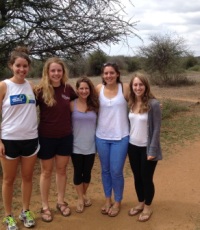
Eva (far right) with four generations of PiAf Mpala Fellows (Sally Goodman, Laura Budd, Stefanie Siller, and Morgan Pecora-Saipe).
In July, BOMA hosted its annual week-long training for its field staff. The BOMA Project works in 15+ villages in Northern Kenya, an arid region where the vastness and sparseness is mind-boggling and the sense of space and time so altered for an urbanite.
The training took place in a village called South Horr, at least a six-hour drive from BOMA’s field office. My supervisor suggested that the driver take me and my coworkers on the scenic route across Northern Kenya, which consisted of a drive up Mount Kulal, a mountain (rather, an eroded-down extinct volcano according to Wikipedia) in the middle of the desert with a rainforest at the top. We embarked on our journey one Sunday morning and eventually began our ascent up Mount Kulal.
Before I knew it, we began to roll down the mountain. The driver pressed on the breaks, turned off the car, and we emptied out. The car could be restarted; it was just a challenge to get it up the rocky hill. Some of my coworkers tried to push it, but that helped the car get absolutely nowhere. Eventually, the driver (who is the best driver I’ve ever encountered) was able to haul the car up the hill. We walked up to meet him, piled in, and carried on with our trip – when just a few minutes later, the whole debacle happened again. So everybody got out and we met the driver at the top of the hill again.
This must have happened about a dozen more times. Each time we got out, I was so nervous that the car was going to break down that I couldn’t bear to watch it go up the hill. My Kenyan colleagues reacted with assurance, kindness, and a lot of humor. There was laughter when I ferociously grabbed the seat in front of me during the even bumpier ride down the mountain once we made it to the rainforest.
I guess they and I both were proud that I made it to the training in one piece. The staff member from the Mount Kulal area granted me with my Kenyan name, Nalotu, which means “she’s arrived.” I look back at this 10-hour drive, which was only the introduction to my first field experience, with affection (and humor). We only saw one other car the whole time, but I never felt alone. The field experience in itself was extremely eye-opening. But a highlight of my fellowship so far has been getting to know the field staff. The camaraderie I experienced during this journey across the north, and the subsequent building of a support system in a place where I had no roots or connections, has been comforting and empowering. It has further reinforced my desire to be part of an effort to empower women from their own communities to create sustainable financial and social systems for themselves. I HAVE ARRIVED!
It is a powerful feeling when you feel like you’ve built a support system for yourself in a country where you initially knew no one. That’s something I didn’t expect, or even think of, from Princeton in Africa, but that I realized is very much needed. The seemingly inconsequential support and reassurance I received during the car ride made it the most memorable one of my life.





